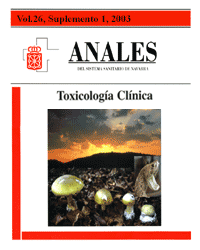Poisoning in children. Methaemoglobinaemia
Keywords:
Intoxicaciones. Tratamiento. Niños. Productos del hogar. Metahemoglobinemia.Abstract
Poisonings during childhood account for 0.3-0.4% of consultations in the emergency pediatric services and constitute a pathology that must be born in mind, because of its frequency, its consumption of resources, its repercussion on the surrounding milieu and the possibility of its prevention. With respect to its epidemiology, the first cause of pediatric poisoning are medicines, with paracetamol outstanding as the most frequent cause of poisoning. In the second place in order of frequency we find products of household use, although their importance in pediatric toxicology rests basically on the fact that some of these products, such as cosmetics, can result in accidental ingestion, almost exclusively involving children. Hospital procedure concerning the poisoned child involves a first phase of life support and stabilization measures, followed by identification of the toxin and measures of detoxification where necessary. Given the broad scope of the issue and the impossibility of covering all of pediatric toxicology, this article describes its epidemiology in our milieu and some considerations are made with respect to dealing with the most frequent or characteristic poisonings involving children. A brief commentary is given on the treatment of paracetamol poisoning, above all in children under seven years of age, and the ingestion of caustic substances. Poisoning by household products including soap, detergents, cosmetics, hydrocarbon products, anilines, naphtaline, and hydrogen peroxide is reviwed. Finally, methaemoglobinaemia’s physiopathology, aetiology, clinical picture, diagnosis and treatment is reviewed.Downloads
Downloads
Published
How to Cite
Issue
Section
License
La revista Anales del Sistema Sanitario de Navarra es publicada por el Departamento de Salud del Gobierno de Navarra (España), quien conserva los derechos patrimoniales (copyright ) sobre el artículo publicado y favorece y permite la difusión del mismo bajo licencia Creative Commons Reconocimiento-CompartirIgual 4.0 Internacional (CC BY-SA 4.0). Esta licencia permite copiar, usar, difundir, transmitir y exponer públicamente el artículo, siempre que siempre que se cite la autoría y la publicación inicial en Anales del Sistema Sanitario de Navarra, y se distinga la existencia de esta licencia de uso.








